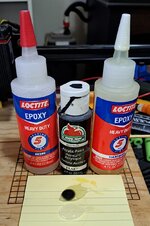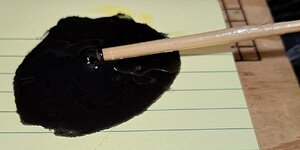Is there a 5 minute epoxy that really sets in 5 minutes? I've tried BSI, Loctite, and JB Weld brands, and they all take a lot longer than 5 minutes. It can be a good 20-30 minutes to be workable. I know I'm impatient, but it's frustrating to me. When it's hot, and I can't work in the garage in the afternoons, I work on pens a lot in the mornings before work.
Just curious what you consider "set"?
Different manufacturers can describe this slightly differently, but, the set time is the time it takes for the epoxy parts to actually start reacting, which is when they start cross-linking and forming a solid bond. That said...the set time is NOT usually when the epoxy is actually, truly "hard" as I think most people think.
It really takes the full cure time, for the epoxy to become fully hardened, properly crosslinked, and actually bonded. Depending on the epoxy, it can be in a varyingly soft-ish state for a good while (good deal longer than the "working time", such as "5 minutes") before it really starts to harden. Then for most of the epoxies I use (which includes Gorilla, Loctite, JB Weld and T-88...the latter of which is my go-to unless I need something clear, in which case JB), the epoxy will be in an intermediate state, which can feel rubbery and flexible, for a good while before truly hardening.
For a good bond, you actually don't want the epoxy to go full hard too quickly. Epoxies are supposed to create these cross-linked polymers, which is where their strength comes from. If an epoxy actually hardened in just 5 minutes, it is doubtful it would have been able to fully cross-link. You would generally feel this, and it wouldn't feel truly hard, even if it wasn't particularly flexible. Good crosslinking requires some time (although not necessarily 24 hours) and the right amount of heat. Warming the parts being glued, then warming the assembly, can help speed up the curing process and improve cross-linking. You don't want to over-heat, as that can cause bubbling, but warming can help speed up the actual curing process to a full hardnes.
The T-88 I use at 70F (room temp) has a working time of 45 minutes, set time of 6-8 hours, and full cure time of 24 hours. Warmed to about 150F, though, it will take 30 minutes to set and reach full cure in 2 hours. (Can be a bit tricky, right around 150F it does start to bubble, so you need to keep it cooler than that, but close, for that fastest set and cure time.)
Anyway. There are, I guess, three key times for any epoxy:
Working Time - The time you have to use and work with the epoxy before it begins to set and continued "working" may weaken the eventual bond
Set Time - The time it takes before the chemical reaction really "sets in" and starts the process of hardening
Cure Time - The time it takes for the cross-linking process to complete and produce a fully hardened bond


